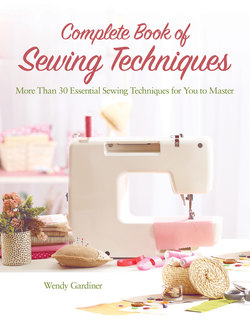Читать книгу Complete Book of Sewing Techniques - Wendy Gardiner - Страница 5
ОглавлениеSergers
Sergers (also known as overlockers) are ideal for fast sewing because they stitch, trim fabric from the seam allowance, and finish all at the same time. They use between 2–8 threads to complete the process, depending on the stitch technique and type of serger. The most common machines have three or four threads while the top of the range have eight thread positions and the option to cover stitch as well as serge. Serged seams are flexible, making them ideal for stretchy fabrics, sportswear, and lingerie.
HOW SERGERS WORK
Sergers do not have bobbins, but have one or two needles and two loopers instead. The needles stitch straight rows of stitching, while the upper and lower loopers form the overcast stitch along the cut edge, interlocking at the very edge. All four are threaded through individual thread tensions with cones or cops of thread held on pins at the back of the machine. It is often necessary to thread in a specific sequence in order to make the machine stitch properly (check your user’s manual for threading guide).
Sergers also have cutting blades positioned to the right of the needle, so that when the machine is operated, the fabric edge is cut before it continues to feed under the foot to be stitched and overlocked. The blades can be lowered to disengage them if desired.
Modern sergers also have differential feed, which means that they evenly feed fabric layers at the same time, avoiding overstretched or puckered seams.
Sergers can be used simply to finish seams quickly and efficiently, or to create decorative finishes when using the special feet available, such as creating a rolled hem, gathering, attaching bindings, and piping. Although feet and needles carry out the same function as on sewing machines, they are rarely interchangeable.
Serger thread is usually finer and comes on large cones or cops (sometimes called bobbins, but not to be confused with sewing machine bobbins) because serging uses far more thread than a sewing machine. If using speciality threads, use them in the loopers which have larger-eyed needles.
Serger cones
Fabric that has been overlocked
A blade cuts the fabric before stitching
STARTING TO STITCH
Always test the stitching on a sample before working on the main project. Start stitching before the fabric is fed through in order to create a chain of stitches 3–5 in (8–10 cm) long. Then, holding the chain at the back of the machine, feed the fabric under the foot (which can be left down or raised to start). Always have the blade at its highest point when starting (turn the hand wheel by hand to raise it). At the seam end, continue stitching for a further 3–5 in (8–10 cm) to create another chain of stitches. Use a bodkin (large-eyed needle) to thread this chain back through the overlocked edge.
HELPFUL HINT:
Before changing or removing needles, place fabric under the presser foot so that the needle cannot accidentally drop down through the throat plate.
Leave a thread tail at the end
THE DIFFERENT PARTS OF THE SERGER
Needles – A three-thread serger has one needle whereas a four-thread machine has two needles, and a five-thread may have three needles. A three-thread machine stitches a straight line and overlocks the edge in one pass which is generally only used for seam finishing. The four-thread serger with two needles stitches a seam plus a parallel straight line and overlocked edge making it a stronger combination, useful for complete garment or project construction. Needles can be removed if the stitch technique doesn’t require all needles in operation, as in flat locking which requires one needle only.
Loopers – The function of the loopers is to form the overlocked stitching at the fabric edge. The looper threads go through their own thread guides, which take them under the needle plate. Threading the loopers can be tricky. The lower looper thread forms the stitching on the underside of the work and the upper looper thread forms the stitching on the top.
Thread guide – Each is usually color coded so that the correct needle or looper thread trail is easier to follow. Cones are placed on pins at the back of the machine and should then be covered with nets (provided in the tool kit) to prevent threads unravelling from the cones unevenly. The thread guide at the back can be raised when in use and lowered for storage.
Thread tensions – Some models have automatic thread tensions on all threads, others have dials to alter the tensions individually. Those with dials usually have shaded or marked optimum tension settings. Tensions may need to be altered when using different stitch techniques or stitching very fine or very bulky fabric. If the looper stitches do not interlock on the fabric edge, the upper looper tension may be too tight, or lower looper too loose. Tighten and loosen the tensions a little at a time.
Stitch selector – As with sewing machines, sergers have stitch options in order to create different finishes. Your user’s manual will advise on any tension alterations and the recommended foot and needles.
